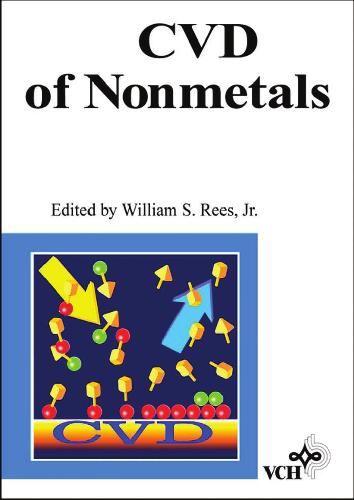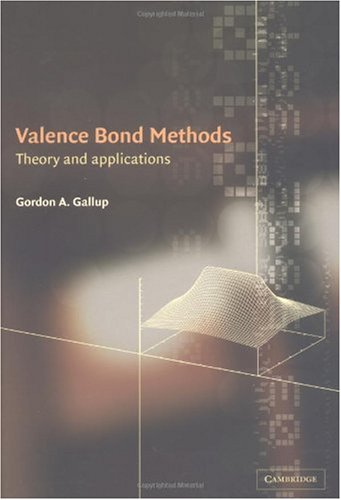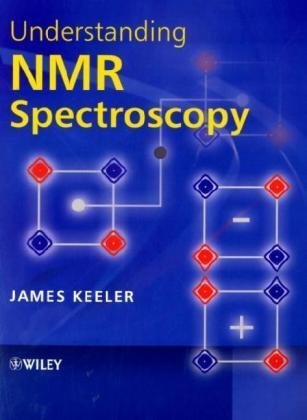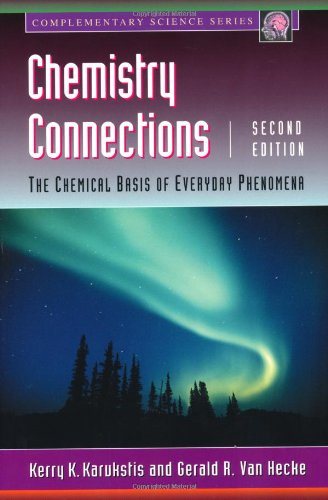Toivo Kodas, Mark J. Hampden-Smith1560818131, 9781560818137, 3527290710, 9783527290710
Table of contents :
CVD of Nonmetals……Page 2
Contents……Page 12
1. Introduction……Page 22
1.1.1 Scope of the Book……Page 23
1.2 Uses of Materials……Page 24
1.2.3 Structural Applications……Page 25
1.3.1 Comparison of Chemical Vapor Deposition Sub-Techniques……Page 26
1.3.1.1 Organometallic Vapor Phase Epitaxy (OMVPE)……Page 27
1.3.1.3 Photo CVD……Page 28
1.3.1.4 Pressure Modifications in CVD……Page 29
1.3.2.1 Molecular Beam Epitaxy (MBE)……Page 30
1.4.2 Important Reaction Locations in CVD Reactors……Page 31
1.5.1.1 System Reactant Input……Page 33
1.5.1.2 Reaction Zones……Page 38
1.5.1.3 Reaction Co-Product Removal System……Page 40
1.5.2 Handling of Precursors……Page 41
1.5.3.1 Thermal CVD……Page 42
1.6.1 General Comments……Page 44
1.6.3 Vapor-Solid Phase Reactions……Page 45
1.6.5 Control of Reaction Location……Page 47
1.6.6 Rate-Determining Steps in CVD……Page 48
1.7 Thermodynamics in CVD……Page 50
1.8.1 Design Considerations……Page 51
1.8.2 Structural Motifs……Page 53
1.9 References……Page 56
2. Superconducting Materials……Page 58
2.1 Introduction……Page 60
2.2.1 Physical Properties of Superconductors……Page 61
2.2.2.1 Crystal Structures of LTS Materials……Page 64
2.2.3.1 Crystal Structure of HTS Materials……Page 65
2.2.4.1 Large-Scale Applications of Superconducting Magnets……Page 69
2.2.4.2 Low-Field Applications of Superconductors……Page 70
2.2.4.3 Superconducting Electronics Applications……Page 71
2.3.1 Nb3Sn CVD Film Growth……Page 73
2.3.1.2 Nb3Sn CVD Reactor Design……Page 74
2.3.1.3 Substrates for Nb3Sn CVD……Page 75
2.3.1.4 Physical Properties of CVD-Derived Nb3Sn Films……Page 76
2.3.2.1 Nb3Ge CVD Precursors and Reaction Schemes……Page 77
2.3.2.3 Physical Properties of CVD-Derived Nb3Ge Films……Page 78
2.3.2.4 Films Effects of Chemical Doping Upon Physical Properties of CVD-Derived Nb3Ge……Page 79
2.3.3 NbC1-yNy CVD Film Growth……Page 80
2.3.3.1 NbC1-yNy CVD Precursors and Reaction Schemes……Page 81
2.3.3.2 Reactor Design for CVD of NbC1-yNy on Carbon Fiber……Page 82
2.3.4 NbN CVD Film Growth……Page 83
2.3.4.2 Physical Properties of CVD-Derived NbN Films……Page 84
2.3.5.2 V3Si CVD Film Growth……Page 85
2.3.5.5 Tic1-yNy CVD Film Growth……Page 86
2.3.5.8 LTS Film Growth by CVD of Hydrides and Organometallics on HotWires……Page 87
2.4 CVD of HTS Materials……Page 88
2.4.1 CVD Precursor Design Strategies for HTS Materials……Page 89
2.4.1.1 Metal p-Diketonate Complexes for HTS CVD……Page 90
2.4.1.3 New Barium Precursors for CVD of HTS Materials……Page 92
2.4.2.1 Compositional Analysis of CVD-Derived YBCO Films……Page 95
2.4.2.2 Structural Orientations of YBCO Films by CVD……Page 99
2.4.2.3 Low Temperature CVD of YBCO Using N20 as a Reactant Gas……Page 104
2.4.2.4 Plasma-Enhanced CVD of YBCO……Page 105
2.4.2.5 CVD of YBCO Films Using Other Precursors……Page 106
2.4.2.6 Alternative Precursor Delivery Systems……Page 108
2.4.2.7 CVD Processing of Technologically Related YBCO Films……Page 111
2.4.2.8 CVD of YBa2Cu408……Page 112
2.4.2.9 Thermodynamic Analysis of YBCO CVD……Page 113
2.4.3 CVD of BSCCO……Page 132
2.4.3.1 In Situ CVD Growth of BSCCO……Page 133
2.4.3.2 BSCCO Films by CVD Using Fluorinated Metal-Organic Precursors……Page 136
2.4.3.3 Doping Studies in the CVD of BSCCO Thin Films……Page 137
2.4.3.5 Novel BSCCO Film Orientations……Page 138
2.4.3.6 Novel CVD Routes to BSCCO Thin Films……Page 139
2.3.4.7 Halide CVD of BSCCO Thin Films……Page 140
2.4.3.8 Thermodynamic Analysis of BSCCO CVD……Page 141
2.4.4.1 CVD of TBCCO Thin Films on Single Crystal Substrates……Page 142
2.4.4.2 CVD of TBCCO Thin Films on Metallic Substrates……Page 149
2.4.4.5 Thermodynamic Analysis of TBCCO CVD……Page 150
2.5 CVD of HTS Lattice-Matched Metal Oxides……Page 153
2.6 Conclusions……Page 157
References……Page 158
3. Chemical Vapor Deposition of Conducting Materials……Page 172
3.1 Introduction……Page 173
3.2 Deposition Techniques……Page 174
3.3.1.1 Introduction……Page 176
3.3.1.2 Precursors……Page 177
3.3.1.3 Properties……Page 189
3.3.2.1 Film Deposition Using Halides……Page 191
3.3.3 Conclusions……Page 192
3.4.2.1 Precursors and Preparation……Page 193
3.4.2.2 Properties and Applications……Page 195
3.4.3.1 Preparation and Precursors……Page 197
3.4.3.2 Properties and Applications……Page 199
3.4.4.1 Precursors and Preparation……Page 201
3.4.4.2 Properties and Applications……Page 204
3.4.5 Conclusion……Page 205
References……Page 206
4. Semiconducting Materials……Page 214
4.1 Introduction to Semiconductors and Formation Technology……Page 215
4.2.1.1 Liquid Phase Epitaxy (LPE)……Page 218
4.2.1.2 Implantation……Page 219
4.2.1.3 Molecular Beam Epitaxy (MBE)……Page 220
4.2.1.4 Vapor Phase Epitaxy (VPE)……Page 223
4.2.1.5 Others……Page 224
4.2.2 Organometallic Vapor Phase Epitaxy (OMVPE)……Page 225
4.2.3 Organometallic Vapor Phase Epitaxy (OMVPE) System Technology……Page 229
4.2.3.1 Reactor History……Page 232
4.2.3.2 Modeling……Page 237
4.2.3.3 Control Systems……Page 239
4.2.3.4 Safety……Page 242
4.2.3.5 Assisted Techniques……Page 243
4.2.3.6 The Deposition Equipment Manufacturers……Page 244
4.2.3.7 Cost of Ownership……Page 245
4.3 The Substrates……Page 246
4.4 The Reactants……Page 248
4.4.2 The Metal-Organics……Page 249
4.4.3 Organometallic Source Vessels……Page 251
4.4.4 Reactant Efficiencies……Page 254
4.5.1 Group II-VI Materials……Page 255
4.5.2 Group III-V Materials……Page 256
4.5.3 Group III-V Nitrides……Page 258
4.5.4 Group IV-IV Materials Silicon, Silicon germanium……Page 260
4.5.5 Carbides (Including and Diamond)……Page 261
4.5.6 Oxides……Page 262
4.5.7 Organic Materials……Page 263
4.6.1 Field Effect Transistors (FETs)……Page 264
4.6.2 Heterojunction Bipolar Transistors (HBTs)……Page 265
4.6.3 High Electron Mobility Transistors (Modulation Deped Field Effect Transistors [(HEMTs (MODFETs)]……Page 266
4.6.4 LEDs……Page 267
4.6.5 Lasers……Page 269
4.6.6 Photodiode Detectors……Page 271
4.6.7 Solar Cells……Page 272
4.6.9 III-V Integrated circuits, Monolithie Microwave Integrated Circuits (MMICs) and Opto-Electronic Integrated Circuits (OEICs)……Page 274
4.7.2 Atomic Layer Epitaxy (ALE)……Page 275
4.7.4 Alternative Sources……Page 277
4.8 Conclusion……Page 278
References……Page 279
5. CVD of Insulating Materials……Page 282
5.2 Applications for Electrically Insulating Materials……Page 283
5.2.1 Device Isolation and Gate Insulation……Page 284
5.2.2 Passivation……Page 286
5.2.3 Planarization……Page 287
5.3.1 Deposition Methods……Page 288
5.3.2 Deposition Variables……Page 289
5.4 Oxides……Page 290
5.4.1.1 Silica (SiO2)……Page 291
5.4.1.2 Silicate Glasses……Page 299
5.4.2 Aluminium Oxides……Page 303
5.4.2.1 Alumina (AI2O3)……Page 304
5.4.2.2 Aluminum Silicates……Page 309
5.4.3.1 Tantalum and Niobium Oxide……Page 311
5.4.3.2 Titanium, Zirconium and Hafnium Oxide……Page 313
5.4.4 Superconducting Metal Oxide (SMO) Lattice-Matched Insulators……Page 315
5.5 Nitrides……Page 316
5.5.1 Silicon Nitride and Oxynitride……Page 317
5.5.2 Aluminum Nitride……Page 321
5.5.3 Transition Metal Nitrides……Page 328
5.6 Sulfides……Page 329
5.6.1 Gallium Sulfide……Page 330
5.6.2 Indium Sulfide……Page 332
5.7 Fluorides……Page 333
References……Page 334
6.1 Introduction……Page 342
6.2.1 Current Status……Page 343
6.2.2 Reactor Designs……Page 345
6.2.3 Stress in Coated Fibers……Page 350
6.2.4 Processing……Page 352
6.2.5 Economic Analysis……Page 360
6.3 Interface Coatings……Page 362
6.3.2 Layered Oxide Structures as Interfaces……Page 363
6.3.3 CVD of Oxides……Page 365
6.3.3.1 Textured CVD Coatings……Page 366
6.3.3.2 CVD of Alumina……Page 368
6.3.3.4 Coatings of β”-Alumina……Page 369
6.4 Composite Consolidation……Page 370
6.4.1 Chemical Vapor Infiltration of Carbon……Page 371
6.4.2 Chemical Vapor Infiltration of Silicon Carbide……Page 381
References……Page 382
7. Other Materials……Page 388
7.1.1.2 Group 2 Fluorides……Page 390
7.2 Metal Oxides……Page 391
7.2.1.1 Titanium, Zirconium and Hafnium Oxides……Page 393
7.2.1.3 Chromium, Molybdenum and Tungsten Oxides……Page 394
7.2.1.4 Iron and Ruthenium Oxides……Page 395
7.2.1.7 Zinc Oxide……Page 396
7.2.2.3 Thallium Oxide……Page 397
7.3.1.1 Titanium Sulfide……Page 398
7.3.2.2 Group 14 Element Sulfides……Page 399
7.4.1 Indium Selenide……Page 400
7.4.5 Antimony and Bismuth Tellurides……Page 401
7.5.1.1 Titanium, Zirconium and Hafnium Nitrides……Page 402
7.5.1.3 Tungsten Nitride……Page 403
7.6 Metal Carbides……Page 404
7.6.1.2 Vanadium, Niobium and Tantalum Carbides……Page 405
7.6.1.3 Chromium, Molybdenum and Tungsten Carbides……Page 406
7.7.1 Elemental Boron……Page 407
7.7.2.1 Titanium, Zirconium and Hafnium Borides……Page 408
7.7.2.3 Molybdenum and Tungsten Borides……Page 409
7.8.1.2 Titanium and Zirconium Carbonitrides……Page 410
7.8.3 Spinels……Page 411
7.8.6 Other Compounds……Page 412
References……Page 413
GIossary……Page 422
Index……Page 436







Reviews
There are no reviews yet.